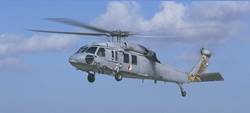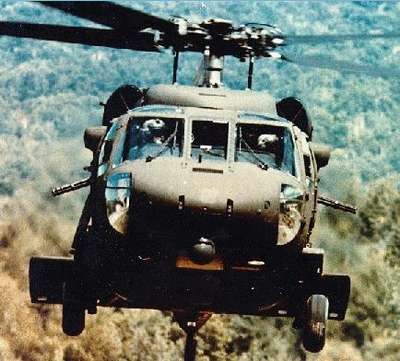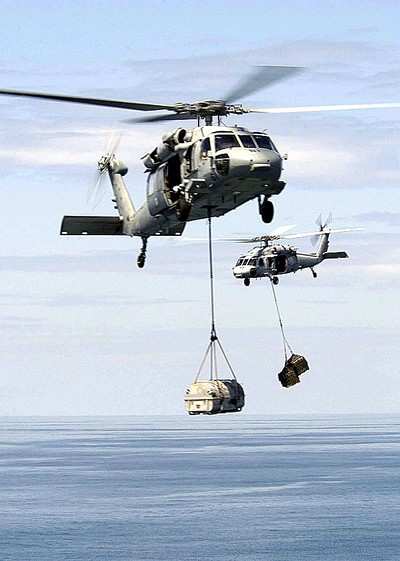It's Now Also A Maritime Mine-Hunter
 The MH-60 Sierra helicopter has a
new mission – to detect, localize, and neutralize all
sea-based mines in order to clear the path for the battle groups of
today and of the future.
The MH-60 Sierra helicopter has a
new mission – to detect, localize, and neutralize all
sea-based mines in order to clear the path for the battle groups of
today and of the future.
The Organic Airborne Mine Countermeasures (OAMCM) program will
combine several new sensor and neutralization systems, which are
being developed or redesigned to fit within the weight and space
limitations of the MH-60S. The MH-60S in the OAMCM configuration is
a critical aspect of the littoral combat ship in development to
perform required organic minesweeping operational capabilities.
Organic airborne mine countermeasures refers to the ability of
carrier battle groups and expeditionary strike groups to maintain
and deploy their own airborne mine countermeasures forces.
Currently, the US Navy is using the MH-53 helicopter to support
its airborne mine countermeasures warfare missions by relying on
forces to be deployed by C-5 Galaxy aircraft. In need of a system
for a more rapid deployment of mine warfare capability that is
lightweight, less expensive, more versatile, and consistent with
the Chief of Naval Operation’s Master Helicopter Plan, the
Navy has turned to the MH-60S.

"This program is designed to support the Helicopter Master Plan
by both reducing the numbers of type aircraft currently in the
fleet and by increasing the capability of the workhorse MH-60S,"
said Kevin Ransford, MH-60S Lead Test Engineer. "In addition, this
capability may be used to outfit CV battle groups with a more
tactically diverse helicopter squadron, one that can perform search
and rescue, vertical replenishment, armed helicopter, and
minesweeping missions. Prior to commencement of this program, these
missions often required two or three different type-model-series of
aircraft; the MH-60S will be designed to be completed with
one."
The MH-60S OAMCM configuration consists of five new mission
subsystems and three support subsystems, "which includes state of
the art electro-optic technology for the detection of near surface
mines," stated Ransford.
The five mission subsystems which will comprise the OAMCM MH-60S
configuration will be the Airborne LASER Mine Detection System, the
AN/AQS-20A Towed Sonar, the Organic Airborne Surface Influence
Sweep system, the Airborne Mine Neutralization System and the Rapid
Airborne Mine Clearance System.

Airborne LASER Mine Detection System
This system is a non-towed system designed to be a quick
response, large-area coverage system for detecting, classifying and
localizing floating and near-surface moored sea mines. It will be a
newly developed mission subsystem, however an experimental
prototype of a system using similar technology has been flown on
the SH-60B helicopter in the past.
AN/AQS-20A Towed Sonar
The AN/AQS-20A towed sonar is designed to be deployed from a
hover and towed by a MH-60S to detect, localize, and classify
bottom, close-tethered, and volume mines. AN/AQS-20A is a newly
developed and technically advanced system based on lessons learned
from the AN/AQS-14 towed sensor package.

Organic Airborne Surface Influence Sweep
The organic airborne surface influence sweep (OASIS) system is
designed to deploy from a hovering helicopter and towed at high
speeds in shallow water in support of limited mine clearance
operations. It will conduct minesweeping missions through the use
of magnetic and acoustic sources.
Airborne Mine Neutralization System
The airborne mine neutralization system (AMNS) is a non-towed
mine neutralization system designed to explosively neutralize
unburied bottom and moored sea mines. Originally developed for use
on the MH-53E, this neutralization system uses sonar and video
sensors enclosed in a torpedo-shaped body allowing the aircraft
sensor operator to guide the sensor to the body and identify the
target prior to operator commanded detonation of the torpedo
warhead and mine.
Rapid Airborne Mine Clearance System
Designed to be a rapid and safe method of near surface mine
neutralization, this system fires a supercavitating projectile from
a gun aboard a hovering helicopter using laser targeting and fire
control algorithms intended to provide a one shot-one kill
capability. This system will use the Bushmaster II MK 44 cannon
currently fielded on the United States Marine Corps AAAV and LPD.
This system will include its own special cabin mounting system. All
other system components, including the targeting system and
ammunition, will be newly developed.

The three support subsystems required for full implementation
and integration of the AMCM configured MH-60S helicopter are the
Carriage, Stream, Tow and Recovery System (CSTRS), the Common
Console, and a tow point with accompanying airframe structure
modifications. All support subsystems are currently in development
and flight test.
Carriage, Stream, Tow and Recovery System
The carriage, stream, tow and recovery system include a winch
and an external carriage/docking mechanism. It will carry and
deploy the airborne LASER mine detection system, AN/AQS-20A towed
sonar, organic airborne surface influence sweep, and airborne mine
neutralization system. Concurrent Technologies Corporation,
Johnstown, Pa, is developing the CSTRS.
Common Console
The common console is designed for a sensor operator located in
the aircraft cabin to control, display, and record information for
all five-mission subsystems as well as communicates with the
aircraft glass cockpit using MIL-STD-1553B technology. The common
console also provides operational control of the winch apparatus
required for the AN/AQS-20 and OASIS tow missions and AMNS sensor
deployment. This system is being developed by Lockheed Martin
Federal Systems, Owego, NY.
Tow Point
The tow point installation is an extensive structural
modification to the baseline of the MH-60S airframe. This
modification will allow the airframe to safely and efficiently
absorb expected loads during the tow missions. This tow point is
located on the lower side of the fuselage aft of the main internal
fuel tank location. In addition to the tow point modification,
fittings in the cabin will be incorporated to support the CSTRS and
common console, as well as provisions for an internal auxiliary
200-gallon fuel tank.
Program management of the MH-60S OAMCM capability is divided
between the Airborne Mine Countermeasures Program, PMS-495, and the
Multi-Mission Helicopter Program, PMA 299. PMS-495 is responsible
for the development of the five sensor systems. PMA 299 is
responsible for development of several support systems and the
integration of the five sensor systems and the support systems with
the helicopter.

Contractor integration testing, including ground and flight
integration of the five individual mission subsystems, will be
executed by The Naval Surface Warfare Center Coastal Systems
Station (CSS), Panama City, FL. and Air Test and Evaluation
Squadron Two One (HX-21), Patuxent River, MD, Sikorsky Aircraft
Corporation and Lockheed Martin Corporation.
Technical evaluation of the MH-60S OAMCM configuration will be
performed by both HX-21 and CSS. Air Test and Evaluation Squadron
One, Patuxent River, MD. will perform operational evaluation of all
five-mission subsystems of the OAMCM MH-60S.
 Classic Aero-TV: The Switchblade Flying Car FLIES!
Classic Aero-TV: The Switchblade Flying Car FLIES! ANN FAQ: Q&A 101
ANN FAQ: Q&A 101 ANN's Daily Aero-Term (04.12.24): Discrete Code
ANN's Daily Aero-Term (04.12.24): Discrete Code ANN's Daily Aero-Term (04.13.24): Beyond Visual Line Of Sight (BVLOS)
ANN's Daily Aero-Term (04.13.24): Beyond Visual Line Of Sight (BVLOS) ANN's Daily Aero-Linx (04.13.24)
ANN's Daily Aero-Linx (04.13.24)








